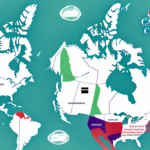Understanding the Customs Rates for Shipping from the US to Canada
When shipping goods from the United States to Canada, it's essential to understand the various customs rates that may apply to your shipment. These rates can significantly impact your shipping costs, so being knowledgeable about them and how they are calculated is crucial. In this article, we provide an in-depth analysis of customs rates for shipping to Canada, including why they matter, key factors that affect them, how to calculate them, common mistakes to avoid, tips for reducing them, and more.
Why Customs Rates Matter for Shipping to Canada
Customs rates are fees charged by the Canadian government for allowing goods to enter the country and are usually paid by the importer of record. These rates can vary depending on the type of goods being shipped, the value of the shipment, and the country of origin. If you're not aware of the customs rates for your shipment, you may face unexpected fees and delays that can impact your bottom line and the timeliness of your shipment. On the other hand, understanding and managing these rates can help streamline your shipping process and save money in the long run.
It's important to note that customs rates are not the only fees associated with shipping to Canada. Other fees may include taxes, duties, and brokerage fees. These fees can also vary depending on the type of goods being shipped and the country of origin. Researching and understanding all the fees associated with your shipment helps avoid any surprises.
Additionally, ensuring that your shipment complies with all Canadian regulations and requirements is crucial. Failure to comply can result in additional fees, delays, and even the seizure of your shipment. Working with a knowledgeable and experienced shipping provider can help ensure that your shipment meets all necessary requirements and regulations.
Key Factors That Affect Customs Rates
Several factors can affect the customs rates for shipping to Canada, including:
- Type of Goods: Different categories of goods may be subject to varying rates and regulations.
- Value of Shipment: Higher-value shipments generally incur higher customs fees.
- Country of Origin: Tariffs can vary based on the country where the goods are manufactured.
- Number of Items: The quantity of items in the shipment can influence the overall rate.
- Weight and Size: Heavier and larger shipments may attract additional fees.
- Applicable Taxes and Duties: Specific goods may have additional taxes or duties applied.
Each of these factors has a different impact on the customs rate, making it essential to have a clear understanding of all the elements involved.
How to Calculate Customs Rates for Your Shipment
Calculating customs rates involves considering several aspects such as the type of goods, the shipment's value, the country of origin, and any applicable taxes or duties. To accurately calculate your customs rate:
- Determine the Harmonized Tariff Code (HTS) for your shipment.
- Use the HTS code to look up the applicable rate in the Canadian Customs Tariff.
- Consider additional fees such as taxes, duties, and brokerage fees.
Working with a customs broker can help navigate this process and ensure you are paying the correct fees.
It's important to note that customs rates can vary depending on the country you are shipping to. For example, shipping to the United States requires using the Harmonized Tariff Schedule of the United States (HTSUS), which is similar to the Canadian Customs Tariff but may have different rates and codes.
Additionally, the mode of transportation affects customs rates. Shipping by air might include additional fees and charges, while shipping by sea may involve port fees and container charges.
Common Mistakes When Calculating Customs Rates and How to Avoid Them
Common mistakes when calculating customs rates include:
- Misidentifying the HTS Code: Incorrect classification can lead to inaccurate rate calculations.
- Failing to Account for All Fees and Taxes: Overlooking additional costs can result in unexpected expenses.
- Ignoring the Country of Origin: Misunderstanding origin rules can affect eligibility for certain rates.
- Poor Valuation of Goods: Under or overvaluing goods can lead to incorrect duty and tax payments.
To avoid these mistakes:
- Ensure accurate classification of your goods using the correct HTS code.
- Include all associated costs (packaging, insurance, freight) when valuing your goods.
- Work with a reputable customs broker who can guide you through the process.
Tips for Reducing Customs Rates on Your Shipping Costs
Reducing customs rates involves understanding the factors that impact the fees and taking steps to mitigate them. Here are some strategies:
- Proper Classification: Accurately classify your goods to ensure you are not overpaying.
- Consolidate Shipments: Combining smaller shipments can reduce per-unit fees.
- Leverage Trade Agreements: Utilize agreements like the North American Free Trade Agreement (NAFTA) to lower customs rates.
- Ensure Accurate Documentation: Provide detailed descriptions, values, and origin information to avoid delays and additional fees.
Staying informed about changes to customs regulations and requirements can also help you adapt and maintain cost efficiency in your shipping operations.
The Role of NAFTA in Customs Rates for US-Canada Trade
The North American Free Trade Agreement (NAFTA) significantly impacts customs rates for US-Canada trade. Under NAFTA, many goods are exempt from customs duties and taxes, offering substantial cost savings for businesses importing and exporting to Canada. However, to qualify for these exemptions, you must meet NAFTA's requirements, which include proving the origin of your goods and submitting detailed documentation.
NAFTA has also increased competition in various industries by allowing easier market access between the US and Canada. While this has provided opportunities for growth, it also means businesses must compete with a larger pool of competitors. Overall, NAFTA has strengthened economic ties between the two countries, benefiting businesses that effectively navigate its provisions.
Recent Changes in Canadian Customs Regulations and Their Impact on Shipping Rates
Canadian customs regulations are continuously evolving, affecting shipping rates and processes. Recent changes include:
- De Minimis Threshold Adjustments: Changes to the threshold exempting small shipments from duties and taxes impact businesses regularly shipping low-value goods.
- Single Window Initiative: This initiative streamlines the customs clearance process, improving shipping times and reducing costs.
- Advance Commercial Information (ACI) Program: Requires carriers to submit electronic cargo and conveyance information before arrival, enhancing efficiency but potentially increasing compliance costs.
Staying updated on these changes is essential for businesses to maintain compliance and optimize shipping costs. More information can be found on the Canada Border Services Agency (CBSA) website.
How to Work with a Broker to Navigate Canadian Customs Regulations
Partnering with a customs broker is an effective way to navigate Canadian customs regulations. Brokers can help you:
- Understand factors affecting customs rates.
- Ensure compliance with NAFTA and other trade agreements.
- Adapt to recent regulatory changes.
- Negotiate lower rates and provide valuable shipping advice.
When selecting a broker, consider their experience in your industry, their licensing and bonding status, and their reputation. A reputable broker ensures your shipments are handled efficiently and compliantly, providing peace of mind and cost savings.
Case Studies: Examples of Companies that Have Successfully Reduced Their Customs Rates When Shipping to Canada
Numerous businesses have successfully reduced their customs rates by implementing strategic measures:
- Clothing Manufacturer: A US-based clothing manufacturer saved money by partnering with a customs broker who corrected errors in their previous declarations and properly classified their products, resulting in lower customs rates.
- Electronics Distributor: An electronics distributor consolidated shipments and leveraged trade agreements to minimize fees and enhance shipping efficiency.
- Automotive Parts Supplier: By accurately valuing their goods and ensuring compliance with all documentation requirements, an automotive parts supplier avoided delays and additional fees, reducing overall shipping costs.
These examples demonstrate that understanding customs rates and implementing effective strategies can lead to significant cost savings and streamlined shipping operations.
In Conclusion
Understanding the customs rates for shipping to Canada is crucial for managing your shipping costs and optimizing your shipping process. By comprehending the factors that impact customs rates, partnering with a customs broker, and applying strategies to reduce fees, you can effectively mitigate the financial burden of customs rates and ensure timely delivery of your shipments.
Additionally, it's important to recognize that customs rates can vary based on the type of goods being shipped. Certain products may incur higher rates due to their nature or potential impact on the environment or public health. Researching and understanding the specific customs rates for your products can help prevent unexpected fees or shipping delays.
Staying informed about changes in customs regulations and rates is also essential for businesses that frequently ship to Canada. Customs regulations can change rapidly, and non-compliance can result in costly fines and shipping delays. Working with a knowledgeable customs broker who stays updated on these changes ensures that your shipments remain compliant and cost-effective.




















